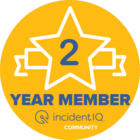Hi all,
We’re evaluating how our team uses the “Resolution Actions” feature in IIQ. We’re trying to better understand where consistent, well-structured Action data can lead to insights that impact operations, planning, or support strategy. We’ve got some ideas of our own, but would like to gain outside perspective as well.
I’d love to hear from other districts:
-
Have you used Resolution Actions data specifically to inform decisions around things like device lifecycle planning, equipment purchases, staffing, or support workflows?
-
Was Actions data the main way you uncovered the insight? Or could the same conclusion have been reached using other fields already filled out by the requestor when they submitted the ticket (like issue type, device type, or category)?
Thanks in advance for sharing!




